Wago terminal blocks: varieties and their characteristics + subtleties of connecting wires with Vago terminal blocks
The twisting of conductors is recognized as obsolete, does not withstand the new requirements for electrical safety by the method of connection, soldering and welding are laborious, and a special tool is required for crimping.
The easiest way is to connect the wires using Wago terminal blocks - special devices that quickly and easily provide reliable contact, and if necessary, fixation in the right place.
Let's look at the types of terminal blocks and how to install them together.
The content of the article:
Features and Benefits of WAGO
The name "Vago" has long been a household name: almost all spring, self-clamping or lever connectors for wires are called that way.
In fact, this is the name of the brand, which produces a wide range of various installation products for switching 1-wire and multicore wires.

Convenient fixtures can come in handy at any stage of electrical work.
Therefore, even when drawing up the project and calculations for the estimate, it is necessary to clarify the approximate number of connecting elements necessary for switching wires in switchboards, junction boxes, wiring devices.
Terminal use cases:
In fact, terminal blocks can be used wherever a fast and reliable connection is required. But you need to be careful not to install non-removable products where separation is expected in the future, and vice versa.
Many installers have long switched to optimizing work - and indeed, they received only pluses from this:
- wiring is faster;
- installation does not need additional tools or skills;
- terminal blocks are always on sale;
- there are many varieties for all types of electrical work, no need to look for substitutes;
- reliable, isolated, protected contact is provided;
- safety standards are observed.
But there are also disadvantages. The main thing is the high price of products. If you need to replace the switchboard in one distribution box, material losses are not noticeable, but when you need to change the wiring throughout the house, buying connectors can result in a tidy amount.
The second disadvantage is the possibility of ignition or melting of products. It should be understood that original Vago products cannot ignite if installation requirements are not violated.
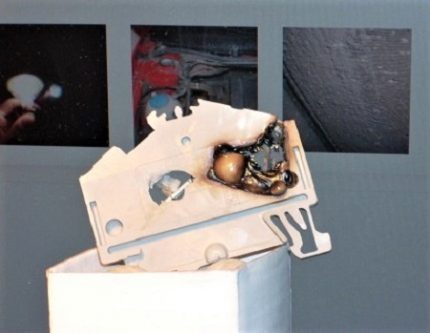
The second reason for fires is the use of non-original products. Countless inexpensive Chinese-made wiring products are sold at Aliexpress. They only look like Vago terminals, in fact it is a cheap fake.
It is clear that they are made of unreliable, fusible, fragile, and possibly hazardous materials.
Distinctive features of original Vago products:
- characteristic shade of flags (levers) or housing;
- marking on the back;
- diagram and labels for wire stripping on the case;
- the contact strips inside the case are thick;
- metal parts are not magnetized.
Accordingly, cheap analogues differ in shade, sometimes in characteristic smell. They do not have full marking and marks, and the inner trims are very thin and magnetized.
Overview of popular types of terminal blocks
There are several classifications of Vago terminals. They can be grouped by size, purpose, method and place of use. But the most convenient division into categories is considered a combined classification, which takes into account both the functionality and the installation location.
Consider the main groups of terminal blocks used for the mains. Terminal blocks with a choke, a capacitor as well as for transformers and printed circuit boards will not be considered because of their rare use in domestic conditions.
Category # 1 - for lighting equipment
The category includes several varieties of products intended for connecting spotlights, sconces, chandeliers and other lighting equipment.
Views:
- 294 and 294 Series Linect® serve for switching thin-core, 1-core, stranded wires without preliminary preparation. Using a special plate, tension unloading can be performed. The maximum current is 24 A.
- 272 series for wires with a cross-section of 2.5 mm², it is divided into insulated and compact terminals.
- Series 293 differs in that it has a direct grounding contact and a mounting leg on a latch.
Category Advantage - Development Push-in CAGE CLAMPdue to which before installation it is not necessary to put lugs on the wires or to seal them.
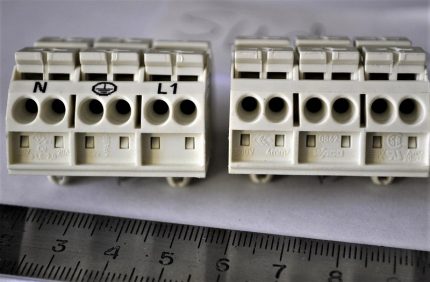
On one side there is an opening for the possibility of connecting a third contact with a cross section of 0.5-0.75 mm².
Category # 2 - for electrical work
This is the largest and most demanded group, since the universal devices presented in it can be useful at any stage of arranging the power supply network.
The basic principle of connecting the conductors is the rejection of screw contacts and the use of spring clamping mechanisms.
Views:
- Series 224 - A specially designed device for connecting a single-core conductor with a thin multi-core.
- 243 series - for servicing low-voltage systems that use 1-wire small cross-section wires - 0.6-0.8 mm.
- 2273 Series - compact but powerful devices to save space in junction boxes.
- Series 273/773 - for 1-core conductors 2.5 mm² and 4 mm². Recognized as the best-selling in the world.
- Series 222 - universal devices for all types of conductors that withstand even powerful currents.
- Series 221 - An improved version of the 222 series with a transparent compact body.
Particularly popular in Russia are products of 221 series. Due to their reduced size, they are often used in confined spaces, for example, when many joints need to be squeezed into a small distribution box.
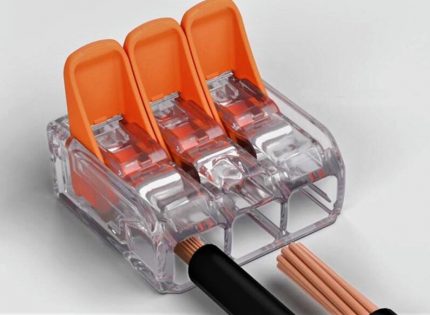
It is easy to install the terminals due to a well-thought-out design: because of the recesses on the sides, the connectors do not slip out of the hands, and the lever does not require much effort for manipulation.
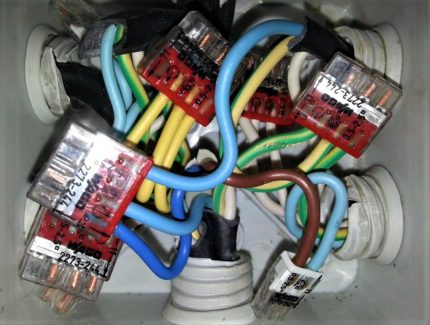
Inside the plastic case are tinned rods that are protected from gases. Despite the apparent fragility, the terminals withstand heavy loads. They are capable of transmitting currents up to 32 A and 450 V at a maximum temperature of +105 ° C.
Universal terminals 222 series are no less popular due to their simple device and reasonable price. Their multifunctionality is explained by the possibility of switching conductors with a cross section of 0.08-4 mm².
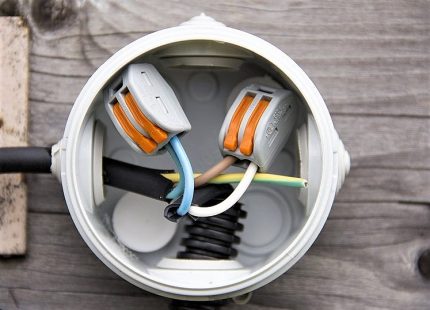
The advantage of the series is the ability to make a bridge connection between two conductors of different cross-section and type, for example, 1-core and thin multi-core.
Category # 3 - for installation on the base
Fixing terminal blocks and modular blocks are not located freely and do not "hang" without support. They are installed on the plane - the mounting base.
Views:
- Series 862 - housing blocks are designed to connect up to 4 conductors, allow you to commute compressed, sealed with ultrasound and unprepared cores.
- Series 260-262 serve for lateral, and 264 - for front mounting. These are modular terminals and pads for mounting on a DIN rail.
- Series 869 used for terminals up to 4 mm². They are fixed on the front side, equipped with support legs or mounting flanges.
What exactly to choose, terminals or blocks, depends on the amount of work, the number of conductors and the tasks of wiring.

Also, all pads have special holes - measuring points for testing after installation. The design is designed so that it is easy to stick a marking tape and indicate the purpose of each module.
Installation Instructions for Vago
You do not need to specifically learn how to use the Vago terminal blocks, the installation process is quick and easy. It is much more important not to make a mistake in choosing and make sure that the products correspond to the parameters of the electrical circuits.
Consider the switching of wires using the example of transparent connection terminals of the 773 series to 3 conductors:
- We clean the end of the wire by about 12 mm - remove the insulation.
- We insert the conductor into the socket, move it all the way. Ideally, the end of the core without insulation should fit entirely into the housing.
- We check the reliability of fastening by slightly pulling the wire in the opposite direction.
We also recommend reading our other material, where we talked about how to choose a stripper for stripping wires. More details - go to the link.
Transparent plastic makes it possible to verify that the core is installed correctly.
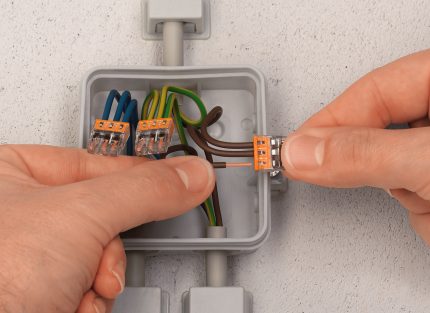
There is a special hole for testing on the back of the wagi for connecting electrical wires. Thanks to him, without opening the case, it is possible to determine the technical parameters of the circuit using an indicator screwdriver.
When installing removable terminals, the design of which is characterized by the presence of a lever, you need to perform a couple of additional steps:
- remove insulation;
- raise the "tongue" up;
- enter the conductor into the hole, push it all the way;
- return the lever to its place;
- visually or slightly pulling, we check the reliability.
The 221 series terminals are the most convenient to install: the wide levers are easy to raise and lower with a touch of your fingers.
Usually, special marks are applied to the terminal strip cases to help clean the wires.
To make the process of connecting wires quick and without hitch, you need to remember a few simple rules:
Be sure to study the passport data of the terminal blocks, they always indicate the range of cross-sections of conductors, maximum voltage, number of cores. You also need to deal with marking electrical wires by color.
Be sure to calculate the total load of all the lines that the terminal connects. In order not to exceed the rated current of the product, it is advisable to select it with a small margin.
Conclusions and useful video on the topic
Installation of terminal blocks 2273:
Instruction for 222 Series:
Wago electrical products are world famous and do not need additional advertising.
Many electricians have already abandoned others methods for connecting conductors and have long been using only self-locking terminals or lever pads of a well-known manufacturer. This is easily explained: installing Vago is simpler and faster, and communication efficiency is higher.
Have you ever used Vago terminal blocks? Please share your impressions of their use. Leave your comments in the box below. There you can ask questions about the topic of the article, and we will try to respond promptly.

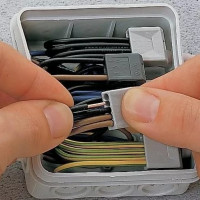 Terminals for connecting wires: which terminal blocks are better and how to work with them
Terminals for connecting wires: which terminal blocks are better and how to work with them 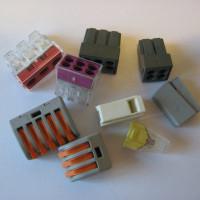 Self-locking terminal blocks: types and scope + recommendations for customers
Self-locking terminal blocks: types and scope + recommendations for customers 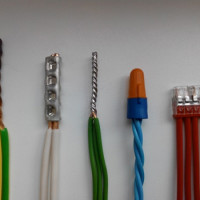 Methods of connecting electrical wires: types of connections + technical nuances
Methods of connecting electrical wires: types of connections + technical nuances 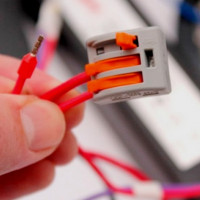 Wire connectors: the best types of connectors + what to look at when choosing a connector
Wire connectors: the best types of connectors + what to look at when choosing a connector 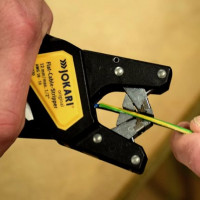 Stripper for stripping wires: rules for selecting a tool for stripping cable and wires
Stripper for stripping wires: rules for selecting a tool for stripping cable and wires 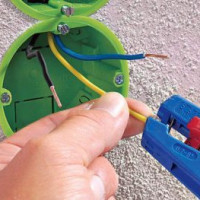 Stripping wires from insulation: methods and specifics of removing insulation from cables and wires
Stripping wires from insulation: methods and specifics of removing insulation from cables and wires  How much does it cost to connect gas to a private house: the price of organizing gas supply
How much does it cost to connect gas to a private house: the price of organizing gas supply  The best washing machines with dryer: model rating and customer tips
The best washing machines with dryer: model rating and customer tips  What is the color temperature of light and the nuances of choosing the temperature of the lamps to suit your needs
What is the color temperature of light and the nuances of choosing the temperature of the lamps to suit your needs  Replacement of a geyser in an apartment: replacement paperwork + basic norms and requirements
Replacement of a geyser in an apartment: replacement paperwork + basic norms and requirements